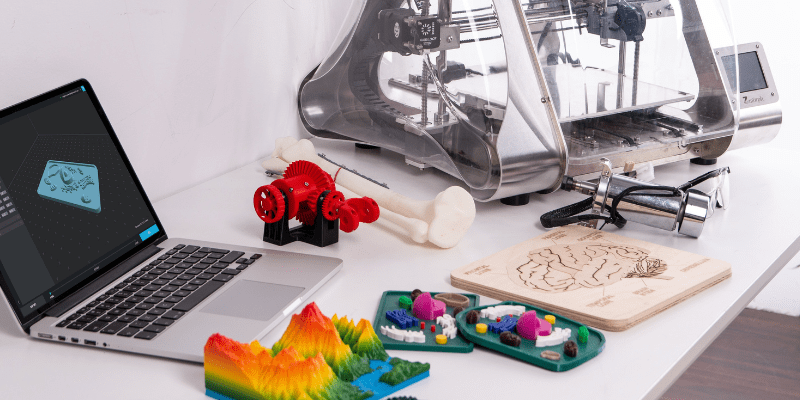Welcome to the forefront of education’s evolution! In today’s digital era, conventional teaching methodologies are undergoing revolutionary transformations through the advent of cutting-edge technologies. Among these innovative leaps, one that stands out is the remarkable 3D printing technology. Envision a classroom where students materialize their most imaginative ideas, where abstract concepts morph into tangible objects, and where creativity knows no bounds. Indeed, the realm of 3D printing has ushered in an era of possibilities for educators and learners alike. However, as with any groundbreaking advancement, the introduction of 3D printing in education comes with its own set of challenges.
Introduction to 3D Printing Technology
3D printing technology is transforming manufacturing and product development across various industries. This technology holds the potential to reshape education by enabling students to design and create their own learning materials. Nonetheless, while 3D printing technology offers immense potential, it is still in its nascent stages, and several challenges must be overcome before its widespread implementation in education.
One of the primary advantages of 3D printing technology is its ability to allow students to swiftly prototype their designs. This expedites testing and iteration before committing to a final product. Additionally, 3D printing facilitates the creation of tailored learning materials tailored to individual student needs.
Nevertheless, the adoption of 3D printing technology in education is accompanied by challenges. The primary hurdle is the cost of both 3D printers and materials. Presently, the majority of 3D printers are financially prohibitive for individual schools or classrooms to acquire. Furthermore, a scarcity of trained personnel capable of operating the printers and aiding students in their projects compounds the issue. Consequently, further research is needed to explore the educational applications of 3D printing technology.
Advantages of Incorporating 3D Printing Technology in Education
The integration of 3D printing technology in education offers a multitude of potential benefits. Firstly, it engenders a hands-on and interactive learning experience for students, thereby enhancing engagement. Furthermore, 3D printing enables the creation of models and prototypes of products or abstract concepts, fostering a deeper understanding of the material being studied. Moreover, the synergy between 3D printing and virtual reality can lead to immersive learning encounters.
Nonetheless, integrating 3D printing technology in education comes with its own set of challenges. The costs associated with procuring and maintaining 3D printers is a pertinent concern, despite the increased availability of affordable options. Furthermore, a learning curve accompanies the utilization of 3D printers, and not all educators possess the time or expertise to become proficient in their operation. Additionally, concerns exist about the potential misuse of 3D printers, including the production of prohibited or harmful items.
Integrating 3D Printing into the Educational Landscape
The rising accessibility and popularity of 3D printing technology has sparked interest in using it within educational settings. Affordable 3D printers have broadened its reach, creating opportunities for hands-on learning experiences.
The incorporation of 3D printing technology in the classroom holds several benefits. It empowers students to visualize and experiment with three-dimensional objects and concepts, expanding their understanding beyond traditional methods. Moreover, it facilitates differentiated instruction, allowing tailored learning materials that cater to individual student needs. Additionally, 3D printing serves as an educational tool for teaching intricate engineering principles and for creating models and prototypes for design projects.
However, this integration presents challenges as well. The cost of equipment and materials remains a significant factor, despite more accessible options. There’s a learning curve for educators, and not all teachers possess the expertise required for effective utilization. Concerns regarding misapplication of 3D printing, such as producing prohibited or harmful items, also need addressing.
Instances of 3D Printing in Global Education
Around the world, 3D printing technology is gaining traction within the realm of education, offering an array of potential benefits for both students and educators. Below are examples illustrating how 3D printing is being employed in education globally:
In the United States, a school district employs 3D printers to fabricate models of organs and body parts. These models aid students in science classes, enhancing their understanding of human anatomy through tangible objects.
In Australia, a university leverages 3D printing to produce prosthetic hands for children born with congenital defects. Collaborating with occupational therapists, engineers design prosthetics tailored to individual needs and print them using specialized 3D printers.
In China, a company named TAL Education Group introduces the ‘Mini Tutor,’ a 3D-printed English-language teaching aid. This small robot, perched on the student’s shoulder, repeats English words and phrases, assisting students in language acquisition.
These examples provide a glimpse into the diverse applications of 3D printing technology in education worldwide. Clearly, this technology possesses the potential to redefine the creation and utilization of educational resources.
Conclusion
3D printing technology stands poised to revolutionize education by offering various avenues for immersive and engaging learning experiences. By affording students access to innovative tools and resources, 3D printing can unlock novel possibilities for educational institutions globally. Nevertheless, the adoption of 3D printing technology in education necessitates thoughtful consideration of both its merits and the challenges it presents. Educators, administrators, and parents should collaborate to make informed decisions when introducing 3D printing into the classroom. This collective effort will ensure that every student can reap the benefits of this cutting-edge technology.

































